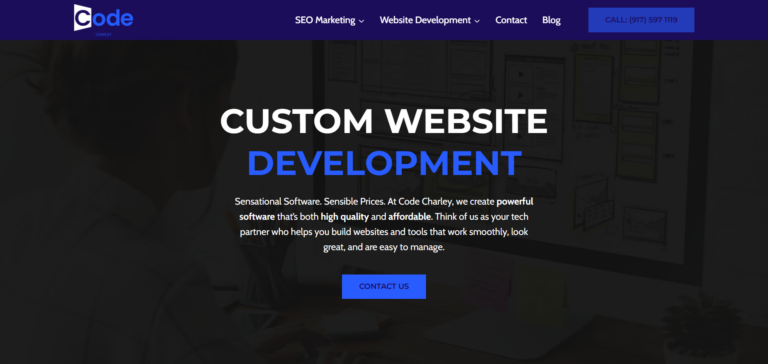Improving Customer Engagement with Engaging Site Design
Within the current digital environment, enhancing user engagement is no longer just a objective but a requirement for businesses striving to succeed online. An effective website design serves as the basis for this engagement, converting occasional visitors into loyal customers. With the quick evolution of tech and user expectations, it's crucial to stay updated on leading web design trends you cannot ignore in 2025. From adopting mobile-first design to understanding the psychology of colors, each aspect can significantly impact how users engage with your website.
As we explore into the intricacies of website design and digital marketing, we shall examine how a striking website can boost your business by providing a visually appealing and extremely functional user experience. Coupled with strong SEO strategies, your website can achieve improved rankings on search engines, drawing more traffic and ultimately boosting conversions. By addressing website development and understanding how to develop effective landing pages, businesses can significantly improve their online presence and enhance engagement with their target audience.
Top Web Design Trends for 2025
As we enter 2025, web design is ready to embrace a myriad of exciting trends that emphasize user engagement and experience. One of the most prominent trends is the growing presence of immersive experiences, like virtual reality (VR) and augmented reality (AR) elements integrated into websites. Such technologies allow users to interact with products or services in a more immersive way, helping businesses differentiate themselves in a crowded digital landscape. By developing an interactive environment, companies can enhance user satisfaction and boost conversion rates.
Another trend gaining traction is the emphasis on minimalist design combined with bold typography. This approach not just simplifies navigation but also attracts attention to key elements of a website. Clean layouts with strategic use of white space ensure that important content is emphasized effectively, making it easier for users to find what they need. As more brands focus on clarity and ease of use, this trend is set to shape the visual identity of websites in diverse industries.
Lastly, sustainability is set to play an essential role in web design this year. As consumers more and more value eco-conscious practices, websites that adopt energy-efficient designs and hosting solutions will resonate more with environmentally aware audiences. Incorporating sustainable design principles can enhance brand loyalty and captivate a clientele that appreciates environmental responsibility. As these trends develop, they are set to redefine how businesses manage their online presence in 2025.
The Interaction of Design and SEO
The connection between web design and SEO is crucial for the success of an digital presence. website development designed website not just attracts users with its look but also plays a critical role in how SEO algorithms evaluate and rank the site. Strong navigation, a simple layout, and mobile-first design are elements that significantly affect user experience and can influence search engine rankings. As a result, including SEO strategies into the design phase is essential for maximizing visibility in search results.
Loading speed is one more key factor where web design meets Search Engine Optimization. Websites that are visually rich yet poorly optimized can experience long load times, leading to elevated bounce rates. SEO algorithms prioritize quick-to-load websites, as they provide a enhanced user experience. Hence, optimizing images and using adaptive design methods are important to ensure that your website engages visitors while following SEO best practices.
Ultimately, the balance between web design and Search Engine Optimization decides how efficiently a website transforms visitors into customers. By creating a user-centered interface that seamlessly integrates SEO elements, companies can improve their online presence. This collaboration not just increases search engine rankings but also fosters user confidence and promotes engagement, leading to higher conversion rates and long-term success.
Enhancing User Experience to Enhance Engagement
Developing an interactive user experience is crucial for keeping visitors on your site and prompting them to engage with your platform. One of the most effective ways to achieve this is by ensuring that your site is easy to explore. Clear menus, organized page layouts, and user-friendly design help users find what they are searching for quickly, reducing annoyance and boosting the likelihood of longer visits. Uniformity in design features also plays a significant role; when users feel comfortable with your layout, they are more prone to engage further with your site.
In furthermore to navigation, the aesthetic of your site significantly impacts user engagement. The psychology of colors, for example, can trigger specific feelings and behaviors. By identifying what hues resonate with your demographic, you can create a visually attractive site that captures interest and encourages actions like clicking a CTA button. Utilizing visuals effectively, optimizing them for web and SEO, and making sure quick loading speeds can boost the user journey, making your site both attractive and effective.
Lastly, the balance between UX and UI is critical for interaction. While UX centers on the overall experience of using the website, UI concerns the specific components that users engage with. Ensuring that both aspects are cohesive, from the layout design to features, leads to higher satisfaction and lower bounce rates. Incorporating feedback mechanisms, such as surveys or inquiry forms, can provide understanding into user likes and help you continuously evolve the design to meet their requirements, ultimately increasing user interaction and results.
